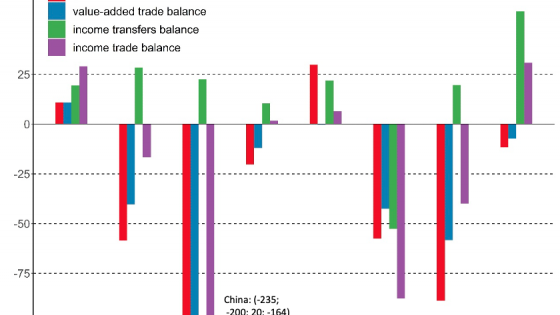With the rise of global value chains, numerous researchers have used world input-output tables (WIOTs) to shed light on international economics issues. These tables are helpful to measure exposure to international risk (Borin et al. 2022), allocate carbon emissions across countries (Airebule et al. 2022), or look into the beneficiary of trade-generated income (Bohn et al. 2021).
In a recent paper with Hadrien Camatte, Antoine Lalliard, and Christine Rifflart (Camatte et al. 2021), we use different WIOTs to analyse cost-push inflation. Results from different WIOTs converge and can be extrapolated to recent years. We show that euro area countries have very different vulnerability to external shocks, which makes it difficult to calibrate any common monetary policy reaction to them. Here, we analyse both the elasticity of consumer prices in Western economies to a rise in energy prices (with a focus on a rise in Russian hydrocarbons), and the elasticity of consumer prices to exchange rate variations.
Elasticity of consumer prices to hydrocarbon prices
Soaring commodity prices in the wake of Russia’s invasion of Ukraine have shed light on the vulnerability of Western economies to energy price cost-push inflation. According to the International Energy Agency, Russia is Europe’s largest natural gas supplier, meeting 34% of the region’s demand in 2021. Germany is put forward as being particularly vulnerable to an increase in Russian natural gas prices (Afunts et al. 2022). Using the World Input-Ouput Database (WIOD), we illustrate which countries are most affected by a rise in energy prices. Our accounting approach aims at illustrating interdependencies and vulnerabilities to cost-push inflation. We do not intend to assess the economic impact of the war in Ukraine, as such an assessment would require in-depths studies with much more sophisticated behavioural assumptions to account for product substitution and price adjustments.
Figure 1 represents the elasticity of consumer prices to a shock on energy prices, with a focus on the impact of a shock on Russian hydrocarbon prices. The impact of a shock on Russian hydrocarbon is negligible for the US, which is broadly self-sufficient in energy and only imports 7% of its oil from Russia. The price impact is also limited for the UK, which imports less than 10% of its oil and gas from Russia. By contrast, for the Netherlands and Germany, which import around one-third of their oil and gas from Russia, Russia accounts for close to 20% of the total impact of an energy price shock. The impact of a rise in Russian hydrocarbon prices is even higher for Eastern European countries such as Finland, Lithuania, and the Slovak Republic, which import more than 80% of their oil and gas from Russia.
Figure 1 Vulnerability of consumer prices to a rise in hydrocarbon prices and to a rise in Russian hydrocarbon prices, WIOD
Source: Trade in Value Added (TiVA), revision 4 (OECD 2018) and author’s calculations.
A caveat is that our computations rely on the fourth revision of Trade in Value Added (TiVA) data, which was published in 2018 and does not represent recent shifts in global trade. In the next part below, we explain how we managed to fill the data gap for the most recent years.
Elasticity of consumer prices to exchange rate variations over two decades
We move to a more original exercise by using WIOTs to illustrate how exchange rate movements affect inflation over two decades, from 1995 to 2019. The transmission of exchange rate movements differs across countries. It depends, among other things, on their respective trade openness, the relative integration of sectors and firms in international production chains, and the currency of invoicing for trade. The originality of this analysis compared to other WIOT-based exercises is that exchange rate variations have different effects for domestic and foreign prices.
In line with the existing literature, we find that in response to a 1% appreciation of the domestic currency, domestic consumer prices decrease by around 0.10% on average at the world level. The impact of exchange rate variations on consumer prices has remained broadly stable over the past two decades. Our results are likely an upper bound. Indeed, our accounting approach relies on the simplifying assumption that exchange rate fluctuations completely pass-through to import prices. However, a large body of literature suggests that the pass-through is incomplete, even in the long run, as a result of slow nominal price adjustments or the pricing-to-market behaviour of firms. Using alternative assumptions would thus entail lower estimates.
Figure 2 shows that our findings are robust to using two different datasets: TiVA from the OECD and WIOD (Timmer et al. 2015, 2016). We also show that a precise assessment of the impact of exchange rate variations on consumer prices can be estimated without resorting to up-to-date WIOTs. The construction of WIOTs is data-demanding and they are typically released with a lag of several years. As a result, most WIOTs are not available for the most recent years. To fill the data gap, we extrapolate the impact of exchange rate variations on consumer prices using up-to-date GDP and trade statistics on imported consumption and intermediary goods. The dotted line on Figure 2 shows that we obtain a reliable estimate.
Figure 2 Elasticity of consumer prices to exchange rate shocks
Sources: WIOD, TIVA, World Bank, BACI, and Camatte et al. (2021)
Heterogeneity and channels of the effect of exchange rate variations on consumer prices
Depending on the country, the impact of a 1% exchange rate fluctuation on domestic prices ranges from 0.05% to 0.22%, reflecting different degrees of openness to trade and differences in foreign product content in domestic consumption. Figure 3 shows that the elasticity is lower for large advanced and developing countries. For instance, we find an elasticity of 0.06 for the US. Within the euro area, the elasticity of domestic consumer prices to the exchange rate fluctuation of the euro differs substantially. It ranges from 0.07 in Italy to 0.18 in Ireland, a small open economy with a large traded sector and a large share of trade outside the euro area. For larger countries (France, Germany, Italy, and Spain) and countries whose trade is concentrated with euro area partners (such as Portugal and Greece), the elasticity is close to 0.10, reflecting a lower openness to trade. The elasticity is twice as high for small open economies like Luxembourg, Malta, Slovakia, and Ireland. The value of the elasticity is closely, but not perfectly, related to the share of imported goods and services in household consumption. Overall, the higher a country’s import share in consumption, the higher the elasticity of domestic consumer prices to the exchange rate.
Figure 3 Elasticity of consumer prices to a shock in the domestic currency for 2019, extrapolated from the 2014 WIOD data
To analyse the role of global value chains in the transmission of an exchange rate appreciation, we identify four channels through which an exchange rate appreciation impacts consumer prices:
- the price of imported final goods sold directly to domestic consumers;
- the price of imported inputs entering domestic production;
- the price of exported inputs feeding through imported foreign production; and
- changes in domestic and foreign production costs in turn pass through to the price of inputs for domestic and foreign goods, causing further production costs variations through input-output linkages.
Figure 4 shows that the first two channels explain three-quarters of the transmission of an exchange rate variation to domestic prices. The last two channels, which reflect the impact of participation in global value chains, play a limited role, with marked across-countries heterogeneity.
Figure 4 Channels of the exchange rate shock effect on consumer prices (WIOD 2014)
Conclusion
Using different WIOTs and extrapolations, we have shown the heterogeneity of countries’ vulnerability to shocks on the price of energetic products, notably Russian ones and to exchange rate shocks. This is an issue for the euro area, as it makes any common policy response difficult to calibrate. Ours is mainly an accounting exercise by the way of large matrix inversion. Although our accounting approach relies on a number of simplifying assumptions, studying cross-country heterogeneity emerging from different input-output structures is an important starting point to a more complete study of cost-push inflation.
Authors’ note: The views expressed are those of the authors and do not necessarily reflect those of the Banque de France.
References
Afunts, G, M Cato, S Helmschrott and T Schmidt (2022), “Russia’s invasion of Ukraine has led to higher inflation expectations of individuals in Germany”, VoxEU.org, 20 April.
Airebule, P, H Cheng and J Ishikawa (2022), “Shared responsibility criterion for allocating carbon emissions across countries”, VoxEU.org, 28 February.
Bohn, T, S Brakman and E Dietzenbacher (2021), “From gross exports to value-added exports to income exports”, VoxEU.org, 15 June.
Borin, A, M Mancini and D Taglioni (2022), “Integration if global value chains might not increase exposure to risk after all”, VoxEU.org, 1 March.
Camatte, H, G Daudin, V Faubert, A Lalliard and C Rifflart (2021), "Estimating the elasticity of consumer prices to the exchange rate: an accounting approach", ECB Working Paper No 2610 / October.
OECD (2018), “What’s new? Differences between the 2018 and 2016 edition of the TiVA indicators”.
Timmer, M, E Dietzenbacher, B Los, R Stehrer and G J de Vries (2015), "An Illustrated User Guide to the World Input–Output Database: the Case of Global Automotive Production", Review of International Economics 23: 575–605.
Timmer, M P, B Los, R Stehrer and G J de Vries (2016), "An Anatomy of the Global Trade Slowdown based on the WIOD 2016 Release", Technical report.
